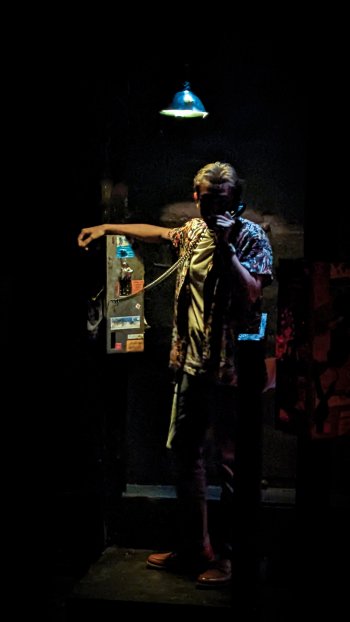Click
A play that attempts to present the bleak, dark characters and settings of a noir film such as Godard’s "Breathless" on stage.

Mohammad Saleen as Del, Shuga Ohashi as Claire and Saman Peyman as Oona in a scene from Drew Pisarra’s “Click” at The Tank (Photo credit: Justin Lahue)
[avatar user=”Scotty Bennett” size=”96″ align=”left”] Scotty Bennett, Critic[/avatar]
Translating a “film noir” style to the stage presents the difficulty of meaningfully bringing together all the critical elements of character, dialogue, and staging to a dark, unresolved, psychological and emotional space. Film allows flexibility in setting, character development, and dialogue essential to presenting a “noir” storyline. While elements of a “noir style” can sometimes be made to work on stage, the musical Sunset Boulevard being an example, the result is not what one may call “theatrical noir.”
Click by Drew Pisarra and directed by James Dean Palmer is a play inspired by the film Breathless, written and directed by Jean Luc Godard and considered a seminal work in establishing French film noir. Pisarra is paying homage to Godard in creating a play that attempts to present the bleak, dark characters and settings of a noir film such as Breathless on stage. He is only partially successful in the task, and ultimately, the play fails to be an entertaining evening of theater.
There are three representations of telephone booths on stage. They have pay phones in them and are dimly lit. A light over each turns on when the characters are in the phone booths. The booths are within two blocks of each other in a rough-and-tumble area of the city.
The story is told through the interactions of three characters, Del, Clare, and Oona, who talk to each other from these telephone booths. It is about the delivery of a paper bag that contains something that Del is giving to Oona as the result of a deal between them.

Mohammad Saleem as Del in a scene from Drew Pisarra’s “Click” at The Tank (Photo credit: Justin Lahue)
It is evening, and Del (Mohammad Saleem) and Clare (Shuga Ohashi) are conferring by phone about a delivery of the package by Clare. She is frightened, and Del is concerned that she will fail to make the delivery. The dialogue is short and sharp and reveals little about what is in the package and the reason for the elaborate delivery process. Del ends the conversation and leaves his telephone booth.
Saleem effectively portrays Del as a somewhat “bossy” man in the pursuit of something that he lacks the emotional ability to understand. He is clear in his project directions and confused about his feelings about the project and the people involved.
Ohashi’s portrayal of Clare is the most straightforward and intense of all the actors. She delivers a solid portrait of a frightened young woman in both her physical actions and in her delivery of lines.
Clare’s doubts begin to bubble up after she hangs up the phone. She talks to herself about not giving up on the project even though she is frightened. As she paces up and down in front of the booth, Oona (Saman Peyman) enters the third booth on stage and calls. Clare’s phone rings five times, and then she answers. It is this moment the drop-off of the package is to be finalized, but things don’t go according to plan.

Saman Peyman as Oona in a scene from Drew Pisarra’s “Click” at The Tank (Photo credit: Noelle Salaun)
Peyman’s presentation of Oona is not as strong as it should be for the type of character being played. While Peyman gives a solid physical representation of the character, the sinister coldness of the character is only hinted at in some of the sharp exchanges with Clare. While Oona is not necessarily evil, she is dark, and given the play’s attempt at a noir sensibility, the quality of darkness is essential to the story.
It is never clear what exactly is in the bag, but the mystery of the bag spins into a metaphysical environment and then back to the reality of the characters’ place in time. The journey is somewhat interesting, but in the final analysis, it doesn’t work. Making sense of the interactions between the characters and their behavior within the story’s structure leaves one with a superficial understanding of the characters and a feeling of not caring. Given the playwright’s intent to make this an homage to Godard, perhaps this sense of nihilism in the storyline tries to evoke the existential nihilism of film noir.
Justin Lahue’s scenic design and technical direction delivers the sense of bleakness required in a noir setting. His representation of telephone booths is abstract but effective given the size of the performance venue. The costume design by Adanne Spencer-Johnson helps in defining the characters but it is not as impactful as the story demands. The lighting by Liz Schweitzer fits the story and is well executed as is the sound design by Lexi Spera.
Click (through September 9, 2023)
The Tank, Imago Theatre with additional support from Atelier 86 and The Drawing Board
The Tank, 312 West 36th Street, 1st FL, Manhattan
For tickets, call: 212-563-6269, or visit https://ci.ovationtix.com/35658/production/1172687
Running time: 50 minutes without intermission
.






Leave a comment